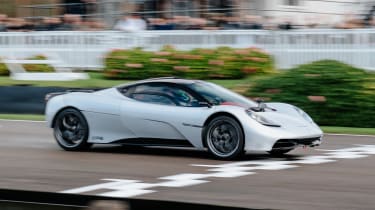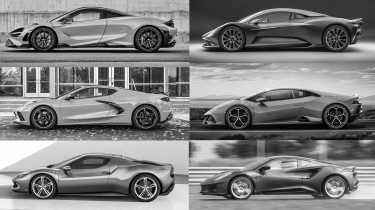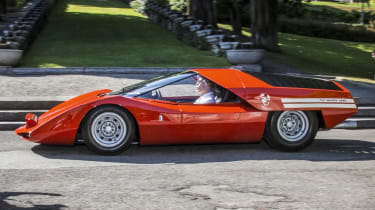How to design a car (part nine): visual differentiation
Today’s supercars are all following the same design formula, argues Stevens, so how do manufacturers differentiate their products?
Whilst the automobile industry has been almost desperately looking for new typologies or for niches within niches to retain the interest of the customer, the sports car has remained an easily defined category. Certainly there has been a tendency for some of the press to get tied in knots with the ‘supercar’ and now the ‘hypercar’ offer. But put simply a sports car is a machine that has two seats and whose primary purpose is to entertain, delight and, to a degree, challenge the owner. The driving experience can be rewarding and hopefully the form will be pleasing.
Marketing departments of manufacturers of all types of car are terrified of reading that ‘all cars look the same’, since style is one of the most compelling differentiators that attracts the customer. But it is easy and eventually very expensive to make a mistake with the ‘looks’ of a new car, hence the inbuilt conservatism of the industry. It’s something that is often resisted by the design departments, but, as always, the money speaks loudest in these matters.
> How to design a car (part seven): getting air in and out
Porsche was the first serious manufacturer to produce a road-going two-seat rear-mid-engine (RME) sports car, principally designed for racing. This was the 1953 550 Spyder, and it was followed in 1958 by the 718. The first series production RME was the 1962 (Rene) Bonnet/Matra Djet, which used an 1108cc Renault Sierra engine together with a Renault Estafette van transaxle. Then in 1963 the De Tomaso Vallelunga was introduced, at the Turin Auto Show, with a Ford Cortina 1500cc engine mated to a VW transaxle with a Hewland gearset.
Colin Chapman’s ambitious Lotus company moved from the front-engined Lotus Elan to the 1966 mid-engined Europa using a Renault engine and gearbox. This basic package and component layout of the sports car has changed very little since. The 1966 Lamborghini Miura was the first high-performance mid-engined, rear-wheel-drive road car whilst all its competitors were traditional, heavy, front-engined, rear-wheel-drive grand touring cars. Now its seems that to be taken seriously all sports car manufacturers must use an RME layout; even conservative General Motors eventually plucked up courage and introduced the mid-engined Corvette C8 in 2020.
So how does one manufacturer differentiate its sports car from another’s? The occupants will all require the same seating space. Seatback angle may differ a little, as may ground clearance and the distance from the driver’s ‘H’ point to the ground. (The ‘H’ point, or hip point, is a legally defined point around which interior legislative requirements, such as vision lines, are based.) However, the roof height is pretty well set by the rules, as is the distance from the pedals to the rearmost seat position. The rake of the windscreen will be set by the glass manufacturer and the maker’s concern for the customer’s forward vision through the screen on a sunny day. This angle will be somewhere between 68 and 72 degrees from the vertical. Visibility legislation sets the side glass sill line, and common sense should set the ground clearance.
At this point there is a narrowing range of opportunities. The position of the radiator will be dictated by the engineers based on weight distribution and required cooling air flow, and the wheelbase will be determined by the length of the engine, the position of the fuel tank and the layout of the gearbox and front crash structure. So what is the designer left with?

The rear overhang is usually a bit of a battleground between engineers and designers, with the exception of the McLaren Speedtail, whose name defines the appearance (and whose looks have grown on me when seen in a dark gunmetal). That battle needs strong nerves and an understanding of the engineering involved if the designers are not to be bullied into working around something they feel is not right.
The side glass is an area for design originality but this boils down to two themes. Either the ‘upturned collar’ look that is typified by the Corvette, Maserati, some Ferraris and Lotuses and the GMA T.50, or an extended second side glass like the rest. The Lotus Evora was almost unique among this group, with a glasshouse language derived from the Europa but much better handled: one line from the top rear corner of the side glass all the way round to the other side glass rear corner.
There is a certain amount of freedom in the side sill area; in the past examples such as the Lamborghini Gallardo carried the door surfaces down to the bottom edge of the car, giving a very heavy look. As cars have become heavier, designers have been trying to reduce the visual weight of their models, and just as with SUVs, MPVs and electric cars an arched line below the doors has become the easy solution.
It looks as if every designer or design department has agreed that the amount of wheelarch thickness above the front wheels should be as slim as possible, but the smoothness with which the peak line flows into the headlight and nose causes problems for some more than others. The bulk of the bodywork over the rear wheelarch sets a real challenge. These range from the elegance of the McLaren GT and 720, through the Corvette C8, where the peak of the arch is too far rearward, to the fat clumsiness of the T.50 and the depth of the Maserati MC20.
With the exception of the Ford GT40, a car designed and built to win the Le Mans 24-hour race, and the late 1960s Lamborghini Miura, a car designed to show two fingers to Enzo Ferrari, high-performance sports cars of the later 1960s were, as I’ve already suggested, heavy, slightly ponderous, front-engined dinosaurs. Strong looking, usually elegant and not at all challenging, they epitomised glorious trips along the Côte d’Azur to a reserved parking space outside the casino in Monte Carlo. There should be no sharp intake of between-the-teeth breath, nor any taste-based disapproval.
However, the Italian design house OSI (Officine Stampaggi Industriali) in Turin, which was founded in 1960 by Luigi Segre, retained links to Ghia and was intended to become a small manufacturing company making limited numbers of specialised cars, surprised the industry. The company produced a remarkable concept car for Alfa Romeo, launched at the Paris motor show in 1966, called the Scarabeo. Engineered by Giuseppe Busso and Orazio Satta Puliga and designed by Sergio Sartorelli, it was based on the tube-frame Tipo 33 race car. Although the road car project was later abandoned, the concept was then developed by Autodelta as a pure race car. It weighed just 700kg and from just 115bhp it had a top speed of 200kph (125mph). Significantly, the Scarabeo owed nothing to any of its contemporaries either in style or engineering; it was original with its sharply defined lines and well-handled surfaces.
An even greater surprise was to follow in 1969 when, at the Brussels motor show, Pininfarina launched the Abarth 2000 Scorpione. Designed by Filippo Sapino, it was based on the 2000 Sport Spider SE010 sports race car developed by Mario Colucci. The 2-litre, 220bhp Abarth engine in a car weighing just 670kg was claimed to produce a maximum speed of 280kph or 175mph. The most interesting fact about this car was that it was rear-engined with the motor behind the gearbox. Despite this challenging layout, Sapino was able to produce a stunningly original form that again owed nothing to its contemporaries, and with the exception of some obviously fifty-year-old details, it is as fresh today as it was in 1969.
What we don’t see today is any evidence of as great a leap forward as Sartorelli and Sapino made all that time ago. Will the adoption of electric powertrains in almost all cars, in just eight years’ time, produce this change? Judging by the design language of present-day electric cars, with their dull proportions and nasty details, this might be too much to hope for.




